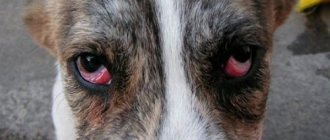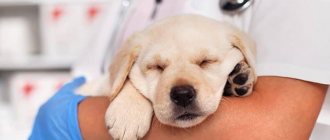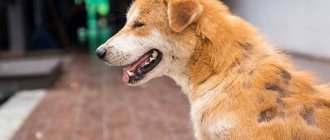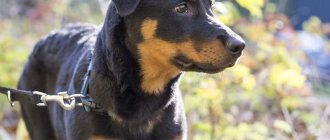Some “intimate” problems associated with digestion can affect not only humans. Pets suffer from them only slightly less often. For example, a dog has gas. This pathology causes many problems both for the pet itself and for its owners. Let’s say, it’s not easy to live in the same apartment with a dog who… every minute “spoils the air” and at the same time resembles an inflated balloon.
Flatulence, as a by-product of bacterial fermentation, often develops due to poor-quality feeding of the animal. Various dietary fibers, complex carbohydrates, overeating or a sudden change in diet are the main predisposing factors. Boxers, bulldogs, Boston terriers and some other brachycephalic breeds are also thought to be inherently predisposed. But not only pure flatulence can be the result of problems with feeding or digestion.
Causes of flatulence in dogs
The formation of gases in a dog's stomach and intestines is called flatulence. When this gas escapes, the dog burps and farts. It would seem nothing supernatural, but the constant problem with increased gas formation causes considerable discomfort to the owner and all family members.
The first thing to consider is the formation of gas in the stomach and intestines; this is a completely natural process. Moreover, the formation of gases during the digestion of food indicates normal functioning of the gastrointestinal tract. It is by the presence of gases in the stomach, belching or “farting” that the “starting” of the gastrointestinal tract is determined after abdominal surgery.
Flatulence is a problem when it is chronic - the volume of gases increases sharply and they acquire a distinct, foul odor. In addition, the dog's abdominal cavity swells, which causes discomfort.
The most common causes of flatulence in dogs are:
- Binge eating.
- Eating unusual food.
- Eating spoiled foods.
If your dog is constantly experiencing flatulence, the most likely cause is an unbalanced diet. Simply put, the food you feed your dog is not fully digested in the gastrointestinal tract. Products that are not completely digested begin to ferment as they move into the large intestine, resulting in the release of gases.
Note! Dogs that are obese or lead an inactive lifestyle are prone to chronic flatulence.
Common causes of flatulence include hasty eating or overeating. This may be due to improper placement of bowls or incorrect feeding schedule. Some dogs are naturally prone to hasty eating; for them, special bowls with a high, structured bottom become a solution to the problem.
Aerophagia or flatulence?
Increased “secretion” of intestinal gases can cause not only flatulence, but also aerophagia . It is usually accompanied by a phenomenon also known as "borborygmy". Chronic stomach grumbling is not its only manifestation. It should not be assumed that all cases of borborygmi are accompanied by flatulence. Excess gases can cause a dog to constantly burp, but in this case they are still evacuated from the body, and therefore there are fewer prerequisites for flatulence. So many veterinarians are of the opinion that in these two cases, the “generation” of intestinal gases occurs for different reasons and leads to different consequences.
Borborygmi, in particular, can occur in dogs that eat food greedily and in large quantities . The faster they eat, the more air enters the digestive organs, and the higher the likelihood of developing belching and similar phenomena. But! If the animal cannot belch these gases back, which leads to the development of flatulence, it is imperative to find out what obstacle is causing this. It is possible that there is a tumor or other foreign body in the intestines or pylorus of the stomach that is preventing the normal passage of gases.
Diseases accompanied by the release of gases
Diseases accompanied by the release of gases are very common and numerous, but in most cases they are associated with nutrition and care.
First, you need to make sure that the dog is suffering from flatulence:
- Your dog farts regularly, and the gas may be odorless or cause severe discomfort.
- The dog experiences abdominal discomfort.
- The pet has abdominal distension.
- You notice that your pet's stomach often growls.
With flatulence, the dog may experience associated problems that are expressed by various symptoms.
In what cases should you go to the doctor?
In some situations, delay can be fatal. You need to go to the veterinary clinic right now if:
- The dog’s stomach became swollen a day ago, but there was no improvement;
- the frequency of vomiting is more than 2 times a day, and the masses themselves contain foreign impurities;
- there is profuse salivation;
- body temperature is higher than normal and the pet is trembling strongly;
- signs of suffocation appeared (shortness of breath, blue mucous membranes).
Before transporting, carefully lay the animal on its side. This will make it easier for vomit to come out while moving.
Depending on the diagnosis, medical or surgical treatment may be required. Most often, surgery is used for volvulus, peritonitis and pyometra.
Additional symptoms and what they mean
For a quick and accurate diagnosis, it is extremely important to notice additional symptoms and know what they mean.
Additional symptoms include:
- Diarrhea.
- Nausea and vomiting.
- Avitaminosis.
- Deterioration in the quality of wool and skin.
- Weight loss against the background of habitual food consumption.
If you notice additional symptoms that regularly bother your dog, it is better to consult a veterinarian. If for some reason you cannot go to a veterinary clinic, you can identify the underlying diseases using the method of exclusion.
Strong unpleasant odor
A strong unpleasant odor against the background of flatulence clearly indicates the process of rotting in the intestines.
Rotting food can be caused by:
- Dysbacteriosis.
- Unbalanced feeding.
- A number of viral and bacterial diseases.
The dog needs to be put on a diet and the dynamics observed, provided that its temperature and health are normal.
If you notice that your pet has become lethargic and refuses food or water, immediately consult a doctor.
Rumbling in the stomach
Rumbling in the stomach is quite natural if it does not cause discomfort. With increased gas formation, the dog may experience stabbing pain. To relieve this condition, any drugs that “bind” gases are used, for example, Espumisan.
Diarrhea
Diarrhea can be a natural reaction of the body to eating low-quality or unusual food. If flatulence and diarrhea are chronic, there is a serious threat of dehydration and deterioration in the dog’s health.
It is important to understand that diarrhea due to poisoning and intoxication is strictly not recommended to be stopped with medication. If you cannot contact a veterinarian, put your dog on a starvation diet and observe the dynamics. During the day, give your dog adsorbents and coating preparations.
Vomit
Vomiting is a natural method of cleansing the body when there is a threat of intoxication or eating something that the dog cannot digest. If vomiting occurs once, the dog remains active and has retained its appetite, most likely the reason is poor quality feeding.
If you notice that your dog is constantly sick and vomiting more than 2-4 times a day, be sure to contact your veterinarian. Profuse vomiting and severe nausea may indicate infection with viral diseases.
The dog doesn't go to the toilet
If your dog has a swollen belly and does not go to the toilet, the reasons may be the following:
- Severe helminthic infestation.
- Constipation.
- Intestinal blockage.
To prevent intestinal blockage by helminths, prophylaxis is carried out once every 3 months, regardless of the season of the year. Treatment for constipation directly depends on its causes, so it is best to consult a veterinarian. Intestinal blockage is a rapidly developing, life-threatening condition that is difficult to diagnose.
Note! Neoplasms in the intestines can lead to constipation due to flatulence. This problem cannot be diagnosed and treated at home.
Flatulence during pregnancy and after childbirth
Flatulence during pregnancy and after childbirth is considered a natural consequence of “rebuilding” the body. As puppies grow, they begin to put physical pressure on the gastrointestinal tract, which can lead to the development of diarrhea, constipation and other problems.
The health of a pregnant dog must be carefully monitored, and if dangerous symptoms appear, immediately consult a veterinarian. If flatulence is caused by natural causes, it is better to switch the dog to a light but nutritious diet until the body recovers after childbirth.
Forms of pathology
Bloating is just a symptom, not an independent disease. It cannot be cured without eliminating the root cause. Depending on the severity of the accompanying symptoms, there are 2 forms of this pathological condition: acute and chronic.
Acute
The acute form occurs suddenly and is accompanied by severe discomfort. Due to pain, the pet may whine restlessly and arch its back. Symptoms quickly increase and are complemented by:
- decreased or complete loss of appetite;
- diarrhea and foamy vomiting with mucus or blood clots;
- breathing problems, shortness of breath;
- bulging eyes;
- hiccups and belching;
- loss of coordination and limb failure;
- blue mucous membranes.
Most often, this picture occurs when there is excessive gas formation, excess air or liquid. All these conditions put pressure on internal organs and can lead to death. To save the four-legged animal, emergency surgery may be required.
Chronic
The chronic form of the pathology occurs unnoticed for both the owner and the pet. It can only be detected during an examination at a veterinary clinic or at the time of relapse, when the symptoms become more pronounced. This picture is typical for gastrointestinal pathologies, kidney diseases and hormonal disorders.
What foods cause flatulence?
Let's figure out which foods cause flatulence:
- Corn.
- Legumes, especially peas.
- Whole milk and fermented milk products - increased gas formation indicates intolerance or a violation of the intestinal microflora.
- Fat and other high-fat foods.
- Any products with spices.
Approximately 40% of adult dogs are lactose intolerant. In this case, immediately after drinking whole milk, the dog develops severe flatulence and diarrhea. To eliminate unpleasant consequences, whole milk is replaced with homemade fermented milk products.
Unplanned pregnancy
The second possible reason is unplanned pregnancy in bitches. Mating could occur without the knowledge of the owner if the dog was left to its own devices for a long time. In this condition, symptoms such as:
- engorgement, enlargement and change in color of the nipples;
- changes in the pet's behavior;
- refusal of some food;
- nausea or vomiting.
In this case, you should immediately show the animal to a doctor - only he will be able to clarify the timing and normality of gestation.
Increased gas formation from dry food
Increased gas production from dry food is a very common problem. The fact is that feed is divided into classes that indicate quality. The lower the grade of food, the more likely it is to contain legumes, corn, soy and vegetable fats. All these products provoke the development of flatulence and dysbacteriosis.
If increased gas formation begins to bother the dog after switching to dry food, there may be two reasons:
- Inappropriate diet composition.
- Too abrupt a transition to a new diet.
For everyday feeding of dogs, it is recommended to feed at least super premium food that does not contain corn, wheat, peas and other legumes. In addition, the dog may have an individual intolerance to any components of the food. If you are sure that flatulence is associated with dry food, try switching your dog to products from another manufacturer.
The dog's body needs some time to adapt to a different type of food. When switching from natural food to dry food, you need to act progressively. At the first stages, dry food is soaked and mixed with the usual food. After 5-7 days, the dog gradually switches to dry granules. When transferring from one dry food to another, within 3–5 days, the new food is mixed with the usual one.
Diagnosis of the disease
The key to a quick and successful recovery for your pet is an accurate diagnosis. To make a diagnosis, the veterinarian examines the dog. It includes external examination and palpation of the painful area. Analysis of gastric contents and scatological studies are carried out. If necessary, gastric radiography, ultrasound and biopsy of the mucous membrane are used.
Only a veterinary specialist after examination will be able to make an accurate diagnosis and prescribe effective treatment.
What to do and how to help your pet
Flatulence is almost always a symptom and therefore cannot be treated as an independent disease. In order to help the dog, it is necessary to determine the root cause and treat it.
To alleviate the condition, dogs use a diet that is easily digestible and contains a small amount of fiber and fat.
If the veterinarian determines that the dog’s condition is chronic, in addition to diet, the pet is prescribed complex therapy. To quickly eliminate discomfort in a dog, special nutritional supplements are used, including those containing probiotics.
Foods that produce gas
First of all, any food is susceptible to gas in dogs if it is eaten impatiently. But it is true that some foods increase flatulence. Stand out :
- Onion.
- Beans.
- Cauliflower.
- Cabbage.
- Soy.
What are the dangers of gases for dogs?
A small amount of gas passing is not a cause for concern and is associated with the digestive process. But excessive flatulence is a sign of trouble. If it is due to eating too quickly or occurs after eating highly fermented foods, we can solve it at home.
But a veterinarian is the only specialist who can diagnose and treat problems such as gas. Additionally, you will need to contact a clinic if you notice other symptoms, such as the following :
- abdominal discomfort;
- I have a stomachache;
- anorexia;
- diarrhea;
- vomit.
Making the right diet for your dog
Provided that the pet does not suffer from food allergies or individual intolerances, those foods that cause fermentation should be excluded from the diet. When we are preparing the correct diet for a dog suffering from flatulence, at least for a while we need to exclude from it:
- Soybeans, peas, beans and heavy grains.
- Sources of coarse fibers, such as bran.
- Yeast.
- Whole milk.
- Anything that contains spices.
- Any products whose quality is questionable.
To help the gastrointestinal tract cope with digestion, all meat and fish products must be boiled.
Meat and fish should not be too fatty. In the process of restoring the mucous membranes and intestinal microflora, broths must be introduced into the dog’s diet.
Since whole milk is completely removed from the diet, it must be replaced with live yoghurts or special nutritional supplements. Tasteless additives in powder form, which are diluted in water, are very convenient.
Why is it important to carry out diagnostics in a veterinary clinic?
Symptomatic treatment provides only a temporary effect. For this reason, it is very important to undergo a complete diagnosis at a veterinary clinic. This is the only way to find out the source of bloating and select drugs that specifically affect it.
Another important point in favor of seeing a doctor is the high likelihood of complications. The most dangerous include volvulus of the stomach and intestines, which can be fatal. Without timely treatment, your pet's condition may worsen. The sooner you take him for examination, the easier the treatment will be.
What to do if you are injured
When your dog sprains a ligament or gets a bruise, reduce the load. Walk with her calmly, slowly, don’t let her run, especially don’t throw sticks down the slides.
If your dog cuts his paw, wash it with an antiseptic and bandage it. If there is a lot of bleeding and the bandage does not stay on, buy a fabric-based adhesive plaster. It sticks well and does not slip off the wool. Do not apply it to a bare wound. First, cover it with a bandage soaked in iodine.
For any fracture, secure the damaged area with a bandage or splint, then immediately contact a veterinarian. Don't forget to wear a muzzle - if the pain is severe, the animal may not control itself. The doctor will apply a cast and prescribe treatment - painkillers, sedatives, as well as drugs that improve tissue regeneration.
The dog should stay at home. Movement should be kept to a minimum, only going outside to go to the toilet. Carry a small dog in your arms. As your pet recovers, it will become increasingly active. Stay strong. Limit jumping and movement.
How to reduce the likelihood of developing gastritis?
Remember that it is easier to avoid a disease than to cure it. Veterinarians have prepared several useful recommendations that will help avoid the development of gastritis in your pet. And the very first of them concerns the dog’s nutrition. To prevent stomach inflammation, select only high-quality food and do not give your pet food from the table.
Other prevention recommendations:
- Do not mix natural and industrial food. Decide what your pet’s diet will be, taking into account its individual characteristics.
- Keep a close eye on your dog while walking. She should not pick up unfamiliar objects or try to swallow them.
- Visit your veterinarian regularly. This is necessary for vaccination and anthelmintic therapy.
- Don't forget about hygiene procedures. An animal can bring pathogenic bacteria from the street onto its paws and fur.
- Never self-medicate or give medications from your home medicine cabinet. If you have any suspicious symptoms, contact your veterinarian.
Remember that the dog's health largely depends on your attention and care. Do not ignore the signs of gastritis - if you have any suspicions, contact a veterinary clinic and begin treatment!
Dietary food: features and rules
It is always necessary to provide your dog with a proper diet, and even more so if you have gastritis. If your pet is accustomed to dry food, then choose diets from special dietary lines. Before doing this, be sure to consult a specialist.
Features of dietary nutrition for gastritis:
- Eliminate fish and meat completely . You can introduce them back into the diet from 10-14 days of gastritis treatment, but only in the form of minced meat (for example, mixed with liquid porridge).
- Add steamed vegetables to your diet. Prohibited vegetables include potatoes, tomatoes, peppers, as well as onions and garlic.
- Give your pet vegetable broths and herbal decoctions . This will ensure rapid recovery of his body.
- Introduce porridge into your diet . Veterinarians recommend giving your dog rice and oatmeal, previously diluted with warm water to a semi-liquid state.











